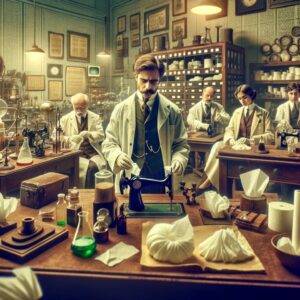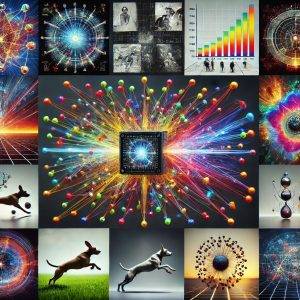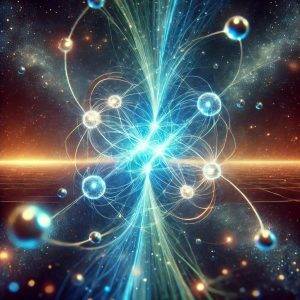Welcome
In an age where innovation moves at lightning speed, it’s easy to be left behind. But fear not, tech enthusiast! Dive deep with us into the next 5-10 years of technological evolution. From AI advancements, sustainable solutions, cutting-edge robotics, to the yet-to-be-imagined, our mission is to unravel, decode, and illuminate the disruptive innovations that will redefine our world.

Beyond Neighbors: Expanding the Horizons of Network Causal Inference
Network causal inference unveils the invisible threads connecting outcomes in large, complex systems. In today’s interconnected world, relationships and dependencies ripple across networks, influencing outcomes in ways we’re only beginning to understand. Whether examining social influence, health interventions, or digital networks, interference among nodes presents challenges to traditional causal analysis. Yet, recent advancements, particularly in adaptive methodologies, have brought clarity to these previously murky waters. A new article delves into how cutting-edge techniques are revolutionizing our understanding of network interference and its practical applications, promising to reshape how we think about causality in interconnected systems. Rethinking Interference in Network Causal Analysis Traditional causal inference often operates on the assumption that interference — the influence of one node on another — is confined to direct neighbors. However, real-world systems are rarely so simple. A tweet’s virality, for instance, may depend not only on immediate retweets but also on how those retweets propagate through broader networks. To
A Sneezing Success In The Remarkable Journey of Kleenex
A glimpse into a 1920s lab where a simple invention, Kleenex, began. Have you ever wondered how something as simple as a tissue became a household essential? Let’s dive into the fascinating world of Kleenex, a product that started its journey with a completely different purpose and ended up in almost every home across the globe. The Unexpected Beginning Kleenex was born in the 1920s, but not as the tissue we know today. Originally, it was designed as a filter for gas masks during World War I. However, when the war ended, the inventors at Kimberly-Clark, the company behind Kleenex, needed a new use for their creation. They repurposed the material as a facial tissue, designed to remove makeup and cold cream. From Makeup to Cold to Flu The big shift for Kleenex came when customers started using it for more than just removing makeup. People began to use these
Why Machines See Differently: Inside the Rise of Encoder-Free Video Models
The dawn of a new era in artificial intelligence has arrived, marked by groundbreaking innovations in video-language understanding. At the center of this transformation lies an enigma: how can machines interpret the complexity of dynamic video content and align it seamlessly with human language? This question fuels a race to push the boundaries of video-language AI, which remains fraught with challenges such as computational inefficiency and limited temporal comprehension. Enter Video-Panda, a disruptive, encoder-free architecture that claims to revolutionize this domain by balancing performance, efficiency, and scalability. With just 45 million parameters — a fraction of its competitors’ size — Video-Panda offers a glimpse into the future of lightweight, highly efficient AI systems. But how does it achieve this delicate balance, and what does it mean for the future of video-language intelligence? The Heart of Efficiency: Encoder-Free Design Traditional video-language models depend heavily on pretrained encoders, often ballooning to billions of parameters. These architectures
The Wide-Ranging Impact of Generative Artificial Intelligence
Students Dive into the World of AI and Its Transformative Economic Influence. A groundbreaking study shed light on a transformative force in technology: generative artificial intelligence (AI). This innovation, far beyond the traditional AI applications, is poised to revolutionize how we interact with technology, impacting job markets, economic structures, and societal norms. Let’s navigate through the intricate tapestry of changes brought about by this AI evolution. Understanding Generative AI Generative AI, a leap from traditional AI, is defined by its ability to learn from vast amounts of data and generate new, original content. This capability positions it as a creator, not just an executor, heralding a new era in technology. Employment Paradigm Shift One of the most significant impacts of generative AI is on the global job market, with profound implications for both job displacement and creation. Let’s visualize this changing landscape of employment with the following graph, which vividly
Quantum Computers Illuminate Hidden Realms of Reality
In the boundless frontier of quantum computing, the study of entanglement scaling has emerged as a lighthouse guiding our understanding of the universe. As researchers grapple with the enigmatic behavior of quantum systems, a central question persists: how does entanglement evolve across a quantum phase transition? Leveraging the cutting-edge power of trapped-ion quantum computers and advanced techniques like the Multiscale Entanglement Renormalization Ansatz (MERA), scientists are unraveling these profound mysteries. A new article embarks on an exploration of entanglement, universality, and the breakthroughs propelling quantum physics into uncharted territory. The Nature of Quantum Phase Transitions Quantum phase transitions differ fundamentally from their classical counterparts. While classical transitions hinge on thermal fluctuations, quantum phase transitions unfold at absolute zero, driven by quantum fluctuations. These transitions mark the reorganization of a system’s ground state, characterized by heightened entanglement. As observed in the transverse-field Ising model, such transitions often reveal a shift from
Understanding Pandemic Responses in Belgium and Sweden
Symbolizing global cooperation during the COVID-19 pandemic. In a world turned upside down by COVID-19, two countries, Belgium and Sweden, chose different paths. Belgium took the route of strict measures, enforcing lockdowns and mandatory rules to control the virus. Sweden, on the other hand, opted for a more relaxed approach, relying on voluntary measures and trusting its citizens to follow guidelines. This paper examines these starkly different strategies, looking closely at how each country’s decision impacted both the spread of the virus and the economy. The Research Duo The researchers, the brains behind this study, aren’t just scientists; they’re like detectives in the world of pandemic management. Working at Ghent University, their goal was to dissect and understand how different approaches to handling the pandemic played out in real life. They were particularly interested in the balancing act between keeping people healthy and keeping the economy running. Key Insights from
Categories
Recent Posts
- Cracking the Code of Motion: The AI That Constructs Skeletons from Chaos 02/23/2025
- AI’s New Gamble: Can Diffusion Models Overtake Autoregressive Giants? 02/23/2025
- When Mathematics Speaks in Code: The Search for an Explicit Formula 02/21/2025
- Beyond Reality: How AI Reconstructs Light, Shadow, and the Unseen 02/09/2025
- The Secret Language of Numbers: Counting Number Fields with Unseen Forces 02/08/2025
Sustainability Gadgets
Legal Disclaimer
Please note that some of the links provided on our website are affiliate links. This means that we may earn a commission if you click on the link and make a purchase using the link. This is at no extra cost to you, but it does help us continue to provide valuable content and recommendations. Your support in purchasing through these links enables us to maintain our site and continue to offer our audience valuable insights and information. Thank you for your support!
The Future of Everything
Archives
- February 2025 (9)
- January 2025 (19)
- December 2024 (18)
- November 2024 (17)
- October 2024 (18)
- September 2024 (17)
- August 2024 (18)
- July 2024 (17)
- June 2024 (29)
- May 2024 (66)
- April 2024 (56)
- March 2024 (5)
- January 2024 (1)
Technology Whitepapers
Share
Favorite Sites
- Transforming commercial pharma with agentic AI
Amid the turbulence of the wider global economy in recent years, the pharmaceuticals industry is weathering its own storms. The rising cost of raw materials and supply chain disruptions are squeezing margins as pharma companies face intense pressure—including from countries like the US—to control drug costs. At the same time, a wave of expiring patents threatens…
- The Download: planet hunting, and India’s e-scooters
This is today’s edition of The Download, our weekday newsletter that provides a daily dose of what’s going on in the world of technology. An Earthling’s guide to planet hunting The pendant on Rebecca Jensen-Clem’s necklace is composed of 36 silver hexagons entwined in a honeycomb mosaic. At the Keck Observatory, in Hawaii, just as many segments…
- An Earthling’s guide to planet hunting
The pendant on Rebecca Jensen-Clem’s necklace is only about an inch wide, composed of 36 silver hexagons entwined in a honeycomb mosaic. At the Keck Observatory, in Hawaii, just as many segments make up a mirror that spans 33 feet, reflecting images of uncharted worlds for her to study. Jensen-Clem, an astronomer at the University…
- Building connected data ecosystems for AI at scale
- The Download: our bodies’ memories, and Traton’s electric trucks
This is today’s edition of The Download, our weekday newsletter that provides a daily dose of what’s going on in the world of technology. How do our bodies remember? “Like riding a bike” is shorthand for the remarkable way that our bodies remember how to move. Most of the time when we talk about muscle memory, we’re…



















